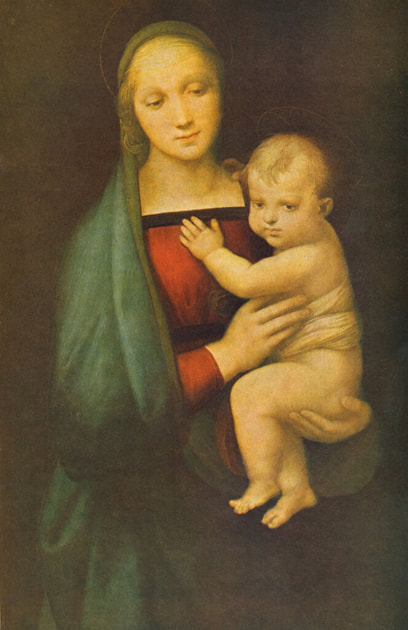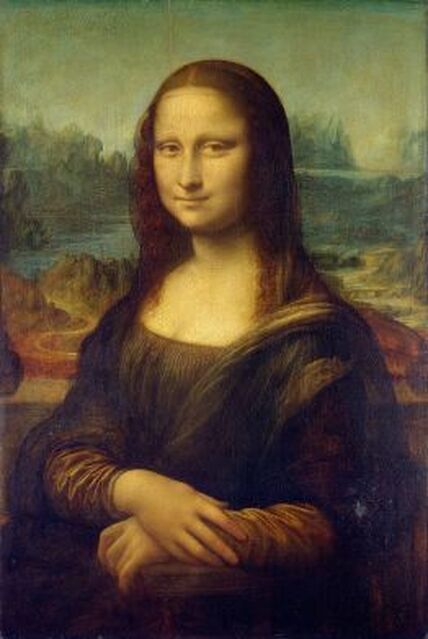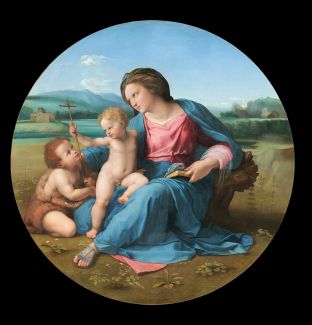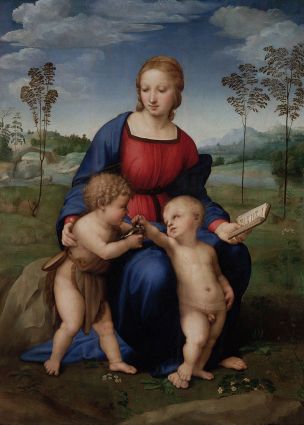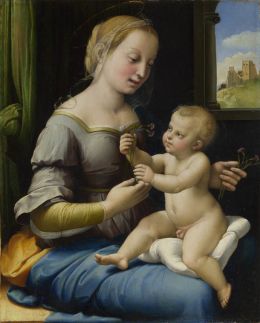|
Where? Room 24 in the Palatine Gallery in the Palazzo Pitti
When? About 1505 Commissioned by? Unknown
This Madonna by Raphael may look like a simple painting, but it is highly admired because of how harmonious and peaceful it is and the motherly love it depicts. It reminds many of how their own mother must have held them as a baby or how they held their own babies (which is something that is hard to describe in words).
Backstory: This painting is often referred to as the Madonna del Granduca (or Gran’ Duca). This name has been given as the painting was owned by the Grand Duke of Tuscany, Ferdinand III. He bought the painting in 1799 for around $600. He loved this painting so much that he took it with him everywhere he went. Because of this, the painting is sometimes referred to as the Madonna del Viaggio (which is Italian for ‘journey’). Raphael painted this work while he was in Florence. During that time he got influenced by the techniques of Leonardo da Vinci who was also in Florence during that time. We can specifically identify the use of the sfumato technique (which is a soft transition between different colors and tones). This technique was one of the specialties of Da Vinci. In this painting, Raphael uses bright colors for the clothes of Mary but makes sure that the transition between the different colors is quite smooth. You can also see this technique applied in the face of Mary, for example, around her eyes. Symbolism: This painting shows the motherly love of the Virgin Mary for Baby Jesus. The blue color of Mary’s mantle symbolizes her role as the Queen of Heaven. The red color of her gown symbolizes the blood of Christ, referring to the crucifixion of Jesus. Madonnas by Raphael: During his career, Raphael painted many Madonnas. Most of these paintings have become very popular because of the way Raphael painted Mary with dignity, grace, and purity, something that he could do like no other artist. The current painting is one of the first Madonnas that he painted. Other highly appreciated Madonnas by Raphael are the Alba Madonna in the National Gallery of Art, the Madonna of the Goldfinch in the Uffizi Museum, and the Madonna of the Pinks in the National Gallery in London.
Who is Raphael? Raffaello Sanzio da Urbino (1483-1520) was born in Urbino (almost 100 miles East of Florence), which explains his last name. He is popularly known as Raphael. When he was 15 years old, he moved to Perugia (about 80 miles Southeast of Florence) where many artists lived, and he probably became an apprentice of Pietro Perugino. He learned very quickly and completed his training by 1500. He gained a reputation as a very talented painter and got his first commissions before he was 20 years old.
Around 1504, Raphael moved to Florence where he was influenced by the works of Leonardo da Vinci who was in Florence between 1500 and 1506. While Raphael learned a lot from other painters, he always kept developing his own unique style. In 1508, Pope Julius II asked him to come to Rome where he spent the rest of his life. Fun fact: The dark background in this painting helps to emphasize the beautiful blue and red colors of Mary’s clothes. While this contrast is admired and one of the strengths of this painting, recent research using x-rays has shown that Raphael originally included a background of architectural structures and a landscape. These backgrounds are typical for the Madonnas that Raphael painted as can be seen in the examples of his other Madonnas above. The dark background that we see in the current version of the painting has been added later on by another painter. This may have occurred around the time of Caravaggio, who successfully incorporated dark background into his paintings. Interested in a copy for yourself? Poster or canvas
Written by Eelco Kappe
References:
0 Comments
Leave a Reply. |
Categories
All
|
- Home
- Blog
-
Museums
- Alte Pinakothek
- Art Institute of Chicago
- Baltimore Museum of Art
- Barber Institute of Fine Arts
- Bargello
- Barnes Foundation
- British Museum
- Church of Sant’Anastasia
- Cleveland Museum of Art
- Courtauld Institute of Art
- Detroit Institute of Arts
- Frans Hals Museum
- Galleria Borghese
- Gallerie dell'Accademia
- Getty Museum
- Guggenheim
- Hermitage Museum
- Kunsthistorisches Museum
- Kunstmuseum Basel
- Legion of Honor Museum
- Louvre
- Mauritshuis
- Metropolitan Museum of Art
- Musee d’Orsay
- Museum of Fine Arts in Boston
- Museum of Modern Art
- National Gallery in London
- National Gallery of Art
- National Museum in Poznań
- Norton Simon Museum
- Ny Carlsberg Glyptotek
- Palace of Versailles
- Palazzo Pitti
- Palazzo Vecchio
- Petit Palais
- Philadelphia Museum of Art
- Prado
- Pushkin Museum
- Ravenna Art Museum
- Rijksmuseum
- San Diego Museum of Art
- Santa Maria delle Grazie
- St. Peter's Basilica
- Städel Museum
- Statens Museum for Kunst
- Tate Britain
- Tate Modern
- Timken Museum of Art
- Uffizi
- Vatican Museums
- Wallace Collection
-
Artists
- Altdorfer
- Anguissola
- Berlin Painter
- Bosch
- Botticelli
- Boucher
- Bronzino
- Bruegel the Elder
- Brunelleschi
- Cabanel
- Caillebotte
- Canova
- Caravaggio
- Carpeaux
- Cezanne
- Cimabue
- David
- Degas
- Delacroix
- De Maria
- Donatello
- El Greco
- Fontana
- Fra Angelico
- Fragonard
- Gauguin
- Gentileschi
- Gericault
- Gonzalez-Torres
- Goya
- Hals
- Hogarth
- Hokusai
- Ingres
- Leonardo da Vinci
- Lippi, Filippo
- Longhi, Barbara
- Lorrain
- Makovsky
- Manet
- Massys
- Matisse
- Merian
- Michelangelo
- Mochi
- Modigliani
- Monet
- Panini
- Parmigianino
- Perugino
- Picasso
- Pisanello
- Raphael
- Rembrandt
- Renoir
- Reynolds
- Rivera
- Rodin
- Rubens
- Scultori
- Seurat
- Steen
- Tintoretto
- Titian
- Toulouse-Lautrec
- Turner
- Uccello
- Van der Weyden
- Van Dyck
- Van Eyck
- Van Gogh
- Van Hemessen
- Vasari
- Velazquez
- Vermeer
- Veronese
- Vigée Le Brun
-
Locations
- Books
- About Us

